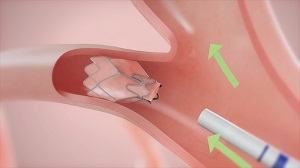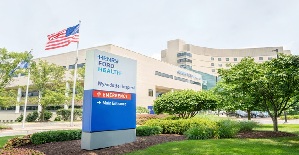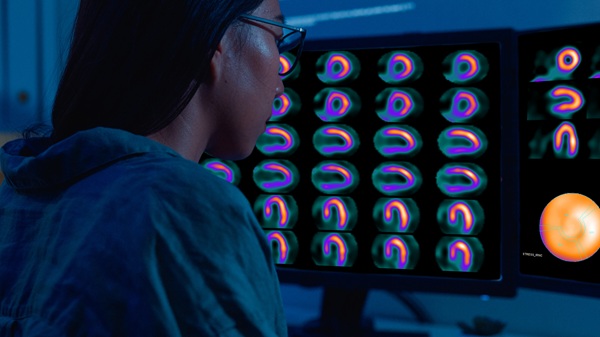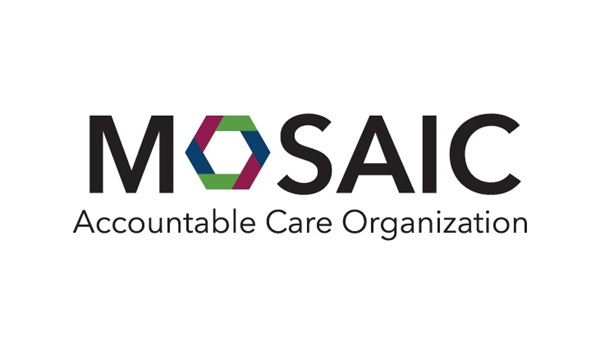Henry Ford Hospital is a State, National Leader for Performing COPD Procedure that Improves Breathing

DETROIT (January 3, 2022) – In just over two years, Henry Ford Hospital has become a state and national leader in performing a minimally-invasive procedure that improves the breathing of patients living with the lung disease COPD.
Called bronchoscopic lung volume reduction, the procedure involves implanting tiny valves into the lungs that effectively block off diseased parts of the lungs and allow the healthier parts to expand and function more efficiently.
Henry Ford pulmonologists recently performed their 150th procedure, a milestone that positions the Detroit hospital in the top three nationally and fifth worldwide, according to data compiled by the valve manufacturer Pulmonx. Henry Ford has performed the most procedures in Michigan.
“This treatment option has significantly enhanced the quality of life for many of our COPD patients,” said Avi Cohen, M.D., a Henry Ford interventional pulmonologist. “Because of damage to the lungs caused by years of smoking or other environmental factors, the simple act of breathing is a constant struggle for COPD patients and affects their day-to-day lifestyle in profound ways.
“After the procedure, patients may feel immediate relief and resume activities they couldn’t do before with renewed energy.”
COPD is the third leading disease-related cause of death in the United States, according to the American Lung Association. COPD, or chronic obstructive pulmonary disease, is commonly referred to as chronic bronchitis or emphysema.
Smoking is the primary cause of COPD, whose early warning signs are shortness of breath or a lingering cough. While COPD has no cure, it can be managed with medication, pulmonary rehabilitation and supplemental oxygen. Lung transplantation is an option under select circumstances. The valve procedure is the newest non-surgical treatment for COPD.
David Germaine of Utica is among the more than 647,000 people living with COPD in Michigan. He underwent the valve procedure in September 2019 and said his outcome was “life-changing.”
“I can’t think of anyone who has been luckier,” said Germaine, a father of four adult children and grandfather of five. He had his wife Patilyn recently visited his daughter’s family in Tennessee and he marveled at having the energy to drive the route both ways.
“I don’t feel like I’m in prison anymore,” he said, adding that he can do simple things like making the bed, mowing the lawn and raking leaves – chores that left him out of breath prior to the procedure. “I couldn’t even make it to the end of the driveway,” without gasping for air, he said.
Germaine is on medical disability after a 40-year career in the heating and cooling business. He has been living with COPD for about 15 years, caused primarily by a three-pack-a-day smoking habit over three decades. He also suffers from pulmonary hyperinflation, a condition associated with emphysema in which air gets trapped in the lungs and causes them to overinflate. This over-inflation eventually leads to shortness of breath that can be debilitating.
For 10 years Germaine brushed aside symptoms of fatigue and shallow breathing to meet his customers’ needs. That changed on the day of his 50th birthday as he pulled his truck into the parking lot of a church in Rochester Hills for a service call to check the furnace and air conditioning unit on the roof.
“I was physically unable to take the ladder off the truck,” Germaine recalled.
Germaine was referred to Henry Ford after his wife learned of the valve procedure while combing the internet for possible treatment options.
The procedure is perfo rmed under general anesthesia and takes up to an hour. Patients are hospitalized for a minimum of three days for monitoring. “I remember coming out of surgery and thinking that a lot had not changed,” Germaine said. “Then the next day, I knew mentally something was going on because I could take deeper breaths.”
rmed under general anesthesia and takes up to an hour. Patients are hospitalized for a minimum of three days for monitoring. “I remember coming out of surgery and thinking that a lot had not changed,” Germaine said. “Then the next day, I knew mentally something was going on because I could take deeper breaths.”
During the procedure, the valves are implanted through a bronchoscope that is inserted down the throat and then into the airways of the most diseased part of the lung. “The valves stop that air from being trapped, giving way for the healthier parts of the lung to take in more air and bring relief of shortness of breath for patients,” Dr. Cohen said. “Shortness of breath is caused when air gets trapped in diseased parts of the lung. This trapped air puts added pressure on the healthy parts of the lung and diaphragm, the muscle that helps in breathing.”
The valves are the first device approved by the U.S. Food and Drug Administration to treat COPD without surgery.
Today, it is not uncommon for Germaine to walk to his neighborhood pharmacy to pick up a prescription. He beams with pride at his endurance to make the 2 ½-mile trek – a feat that was unthinkable two years ago.
“If you were to look at me in a crowd,” he said, “you wouldn’t know there’s anything wrong with me.”
To make an appointment for a consultation about the procedure, patients may call 313-916-1063.
###
NEWS MEDIA ONLY may contact: David Olejarz / David.Olejarz@hfhs.org / 313-303-0606
.svg?iar=0&hash=F6049510E33E4E6D8196C26CCC0A64A4)

/hfh-logo-main--white.svg?iar=0&hash=ED491CBFADFB7670FAE94559C98D7798)







